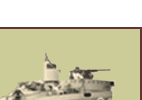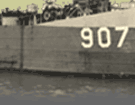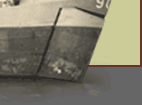





 |
 |
 |
 |
| MENU: |  |
 |
|
|
After a shakedown cruise on Chesapeake Bay the 907 moved to Norfolk, VA where the ship was loaded with the LCT 1015, a Crash Boat (RPC) and their crews, and 100 men from a Repair Unit. Both decks were also loaded with equipment consisting of derricks, tractors, miscellaneous machinery/ tools, fuel, and ammunition. On June 2, 1944 the 907 set sail for North Africa. After about 16 days at sea which was rather uneventful, except for some heavy weather, the Rock of Gibralter was sighted. On June 22, 1944 we reached our destination, Karouba, which is an amphibious base about 4 miles from Bizerte, Tunisia. From June 29 through August 11, 1944 the 907 moved troops and equipment northward along the coast of Italy; Salerno, Naples, Civitovecchia, Nasida, and Pozzuoli. Also Porto Vecchio, Corsica. During that time several incidents took place that had a significant bearing on the ship and the timing of her efforts: On July 6 the 907 hit a sunken ship in the harbor of Cictovecchia causing damage to the port screw. It was repaired in a Naples dry dock. On July 26 causeways (pontoons) were loaded on both sides of the ship which was evidence that an invasion was not far off. On August 8 the 907 was rammed by the LST 988 which damaged her stern anchor. Repairs were made immediately by the crew of the Delta, a repair ship. On August 11, 1944 the 907 joined the armada of ships gathered in the Bay of Naples. There were ships of every type imaginable, including those from allied countries. About 400 troops from the famed Texas Division were aboard the 907. On August 13, 1944 the crew was notified of the invasion of Southern France: D-Day, August 15, 1944 at 0800 hours. Insructional sessions were held to inform the crew of their specific duties upon reaching the invasion area. The invasion fleet left the Bay of Naples this date. On August 15, 1944 the 907 reached its destination off the coast of Southern France. GQ was sounded at 0500 and light gun fire started at 0600. After that, heavy salvo’s from off-shore protective battleships, etal started and lasted almost two hours. At about 0800 hours the small landing craft headed for the beaches, identified as Red, Yellow, and Green. Following that, the 907 landed on Green Beach at 1515 hours where she was shelled but did not receive a direct hit. Several crew members received shrapnel hits but only two reported minor injuries. After unloading the 907 found herself stuck on the beach. Finally, with the help of an Army bulldozer, the ship was freed at 1610 hours. The ship was then ordered to Yellow Beach to drop the pontoons. During this operation enemy air fire was encountered but with no damage or injuries. The ship departed Yellow Beach at 2400 hours. Four days later the 907 made another landing on Green LST 907 History – 2- Beach along side the LST 282, which had been demolished and was the only major Naval casualty in the invasion of Southern France. After the invasion, and for several months, the 907 moved troops and equipment between many ports on the Mediterranean including those in France, Africa, Italy, Sicily, and the islands of Corsica and Elba. On May 7, 1945 while in Leghorn, Italy the crew received word that the war was over in Europe (V-E Day). The 907 left Leghorn that day and arrived in Bastia, Corsica on May 8 in time for a “huge” celebration which many of the crew participated in ashore. The 907 was scheduled to return to the United States about the middle of May, 1945. The ship was in the process of being loaded in Oran, North Africa when orders were received to unload and proceed to Trieste with about 100 British troops and related equipment. The ship, along with others arrived in Trieste on May 29, 1945 upon which she was unloaded and then tied up at a pier overlooking some of the main streets of the city. For a few hours the ship was on an “alert” status with the starboard guns trained on the streets. Although the presence of Tito’s gorillas was obvious, the ship was not involved in any combat. The 907 left Trieste on May 30, 1945 and proceeded to Palermo, Sicily. The ship then returned to Oran on June 24, 1945 and loading operations began for the trip back to the United States. The 907 departed Oran and after one stop in Casablanca to pick up more passengers the ship left for the USA on July 3, 1945. She arrived in New York City on July 18, 1945 and was tied up at Pier 26 after a calm, pleasant voyage. The 907 proceeded to Houston, Texas where it was to be refitted and repainted for Pacific duty. The crew was given a 30 day leave for the month of August, 1945 during which V-J Day occurred. A highlight of the 907’s peace time mission was a trip from New Orleans to Paducah, Ky. to celebrate Navy Day, October 10, 1945. She was beached there for about a week and open to the public. Following that the 907 was involved in maneuvers and exercises off the New England coast and carried out navigational experiments for Sperry-Rand. On October 18, 1946
the LST 907 was decommissioned
and on November 25, STR August, 2003 |
| © 2003 | Updated: Oct. 10, 2005 |